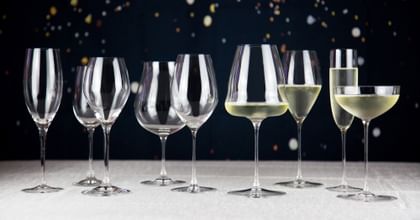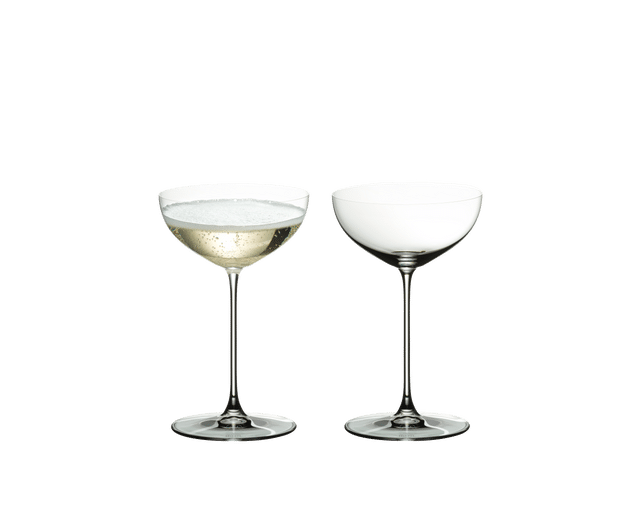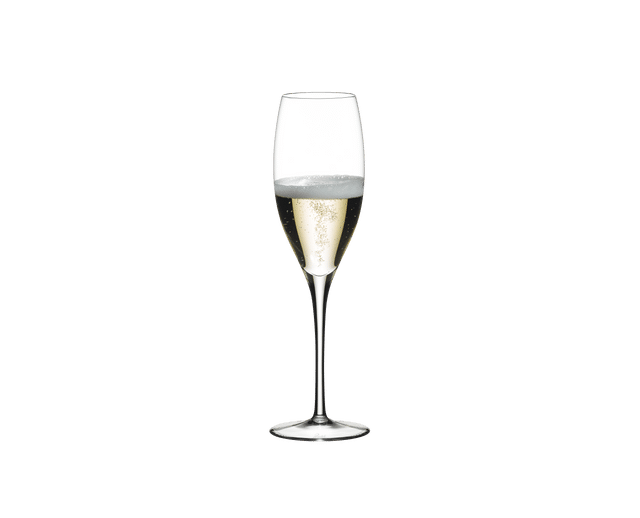Conocimientos
La evolución de la copa de champán

No hace mucho tiempo agarrábamos nuestras fieles copas en forma de flauta cada vez que abríamos una botella de champán. Sin embargo, desde hace unos dos años surge la pregunta sobre la mejor manera de servir el champán. Sabemos desde hace cuarenta años que la forma de la copa tiene un impacto en la percepción que tenemos del aroma y del sabor. Entonces, ¿por qué con el champán seguimos pensando de forma diferente?
La mayoría de los champanes están hechos de tres variedades de uva: Pinot Negro, Chardonnay y Pinot Meunier y algunos de los métodos de producción son los mismos para vinos espumosos y vinos sin gas. La diferencia importante se encuentra en las burbujas.
Imagina que compras una botella de buen vino tinto. ¿Lo abrirías y lo echarías en la taza más cercana? ¿O quizá lo decantarías, comprobarías la temperatura, pensarías cuál es la mejor copa para ese vino y lo saborearías durante una comida?
Nos alegramos de cambiar las copas Pinot Negro por copas de Shiraz cuando cambiamos de una bebida a otra, así que, ¿por qué permitimos que las burbujas del champán dominen nuestros hábitos? Tiene mucho que ver con las tradiciones y con cómo la historia del champán ha conformado nuestra visión de qué recipiente usar.

La copa coupé
Los rumores dicen que la forma de esta copa está inspirada en el pecho izquierdo de María Antonieta. Sin embargo, el origen de esta copa es anterior a la reina de Francia, por lo que, aunque es una buena teoría, no es cierta.
Aun así, la copa coupé tuvo mucha popularidad durante su reinado, pues el champán de la época era más dulce y almibarado. Los lados cortos del platillo y su cuenco poco profundo facilitaban la inmersión del pastel en él. ¿Un capricho? Sí, pero seamos sinceros: si pudieras mojar tu postre en champán, ¿no lo harías?
Esta copa reapareció en la década de 1920 y de nuevo en los años 60. Después de esto, su popularidad resurgió hace unos años para decepción de los amantes del champán. Aunque puede ayudarte a sentirte como una flapper, su forma es completamente ineficaz cuando se trata de expresar el perfil del vino.
El diseño abierto provoca que las burbujas y el aroma se disipen casi al momento, si consideramos que el 70 % de nuestra percepción del sabor proviene del aroma. Es decir, estás perdiendo una gran parte de la experiencia por estar a la moda.
¿Y después del platillo de champán?
Hace unos cincuenta años, el champán era mucho más barato que hoy, por lo que muchos más bebedores tenían acceso a él. Aunque pueda parecer positivo para el negocio, las casas de champán solo podían producir calidad a un ritmo determinado, y la demanda superaba a la oferta.
Así que hicieron lo que cualquier grupo de empresas inteligentes haría: cambiar el discurso alrededor del champán. Al igual que la industria del diamante nos convenció de que los diamantes son la única opción para pedir matrimonio, la industria del champán nos convenció de que esta bebida es algo especial reservado para las celebraciones. De esta manera pudieron subir el precio, haciéndolo menos accesible.

La flauta
Una vez esta bebida se había convertido en algo para ocasiones especiales, los bebedores de champán necesitaban una copa que permitiera compartir una botella entre varias personas. El diseño delgado de la flauta era perfecto para brindar y tenía una capacidad prudente. Como resultado, la misma copa se ha convertido en un símbolo de celebración. Si vas a casa de algún amigo y ves copas de forma de flauta sobre la mesa, automáticamente sabes que se celebra algo.
Las flautas, además, mejoran las burbujas. Todos los productos de calidad tienen un pequeño rasguño o marca en la base que agita el champán haciendo que permanezca burbujeante mientras bebes.
La parte negativa es que no permite la expresión perfecta del aroma debido a su estrecha abertura. Tampoco la flauta con forma de tulipa y un cáliz redondeado proporciona una experiencia aromática completa.
En 2013 Riedel comenzó con sus talleres sensoriales para encontrar la forma de copa que mejorar lograra el equilibrio y la expresión. Descubrimos algo que llevábamos tiempo sospechando: que la mejor copa para beber champán es la copa de vino.
Beber champán en una copa de vino es tan simple como eso. Transforma el champán de algo que es solo para brindar en algo más valioso de saborear y disfrutar. En nuestros talleres determinamos dos formas ganadoras dependiendo del estilo del champán.

La copa
Una copa alta de vino blanco con forma de tulipa es la adecuada para champán más suave como Blanc de Blancs, hecho principalmente a partir de uva Chardonnay. El modesto tamaño del cáliz desarrolla los aromas sin sobrecargarlos, en especial en el champán vintage, donde el tiempo ha hecho que las características sean más complejas.
Para elevar los champanes rosados más opulentos, procedentes principalmente de las uvas Pinot Negro y Pinot Meunier, el cáliz Pinot Negro del Nuevo Mundo es insuperable. Superó con creces a las flautas porque muestra una impresionante profundidad de carácter.
Nuestra serie RIEDEL Veritas es la primera en el mundo que sacó una copa (no una flauta) diseñada específicamente para beber champán como si bebieras vino sin gas. La copa de champán RIEDEL Veritas tiene un cáliz curvo en forma de huevo con una pequeña abertura que envuelve el aroma.
Desde entonces, hemos organizado comparaciones de flauta y copa con bebedores habituales de vino y cada participante sin excepción se sorprende de la diferencia. Como resultado, todas las nuevas líneas de Riedel las desarrollamos con esta forma de cáliz para champán en lugar de la flauta.
En las propias palabras de Maximilian J. Riedel, de la 11ª generación: «el champán es un vino y se le debe tratar como tal. Tanto disfrutando de un Blanc de Blancs como de un Cuvée, nuestra copa de vino para champán permite que la gama de aromas del champán se expanda de una manera que no es posible con una estrecha flauta».
¿Qué significa todo esto?
Ambos lados del debate continúan en una acalorada discusión. Se dice que Dom Pérignon fue el primero en adoptar la flauta como el recipiente elegido para el champán, afirmando que le gustaba «observar el baile de los átomos resplandecientes». Por otro lado, Oliver Krug, actual director de Krug y tataranieto del fundador, insiste en que «un gran champán no puede ofrecer su máxima expresividad en una copa estrecha».
La mejor copa de champán para ti se basa en cómo y cuándo disfrutas del champán y qué estilos te gusta beber. Aunque no recomendaríamos beber champán añejo en un vaso de plástico, quizá eres muy tradicional y necesitas la clásica flauta, o tal vez te gusta ir por delante de los demás y beber champán en tus vasos sin tallo de la serie O Tumblers.
Pero si eres alguien a quien le gustan las cosas buenas, haz una rápida comparación la próxima vez que abras una botella especial. Nuestra única advertencia: no lo intentes con muchos comensales porque cuando bebas champán en una copa de vino para champán, ya no lo querrás compartir.
Ubicaciones